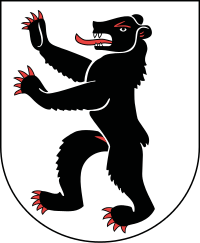Pizzle

Pizzle is an old English word for penis, derived from Low German pesel or Flemish Dutch pezel, diminutive of pees, meaning 'sinew'.[1] The word is used today to signify the penis of an animal,[2] chiefly in Australia and New Zealand.[3]
Original uses
It is also known, at least since 1523, especially in the combination "bull pizzle", to denote a flogging instrument made from a bull's penis – compare bullwhip.
In Heraldry
| Wikimedia Commons has media related to Vilené in heraldry. |
In heraldry, the term pizzled (or vilené in French blazon)[4] indicates the depiction or inclusion of an animate charge's genitalia, especially if colored (or "tinctured") differently.[5]

The bear in the coat of arms of Appenzell is represented pizzled, and omission of this feature was seen as a grave insult. In 1579, the pizzle was forgotten by the printer of a calendar printed in Saint Gallen, which brought Appenzell to the brink of war with Saint Gallen.[6][7][8]
Modern uses
Animal consumption
Pizzles, or Bully Sticks, are almost exclusively used/produced today as chewing treats for dogs.[2]
Glue
The pizzle of a bull was commonly rendered for use as glue.[9]
Human consumption
In addition to being used as a dog treat, pizzles are also eaten by humans for their purported health benefits (according to Traditional Chinese Medicine) such as being low in cholesterol and high in protein, hormones, vitamins and minerals such as calcium and magnesium,[2] although there is little empirical evidence to support these claims. Pizzles for human consumption are prepared either by freezing or by drying. Scottish deer pizzles are thought to boost stamina and were used by Chinese athletes at the 2008 Summer Olympics.[2][10] Pizzles can be served in soup, and if they have been dried they can be turned into a paste. Pizzles may also be mixed with alcoholic beverages or simply thawed (if frozen) and eaten.[2] In Jamaica, bull pizzles are referred to as "cow cods" and are eaten as cow cod soup. Like many pizzle-based foods, cow cod soup is claimed to be a male aphrodisiac.
References
- ↑ "Online Etymology Dictionary". Retrieved 2009-03-30.
- 1 2 3 4 5 "Beijing Olympics 2008 in short". The Daily Telegraph. 21 Aug 2008. Retrieved 2009-03-31.
- ↑ pizzle, OED
- ↑ Rietstap, J. B. (1884). "Armorial général ; précédé d'un Dictionnaire des termes du blason". G. B. van Goor zonen: XXXI.
Vilené: se dit un animal qui a la marque du sexe d'un autre émail que le corps
- ↑ http://www.heraldica.org/topics/sex.htm (accessed July 13, 2016).
- ↑ Neubecker, Ottfried (1976). Heraldry : sources, symbols, and meaning. New York: McGraw-Hill. p. 120. ISBN 9780070463080.
- ↑ Strehler, Hermann (1965). "Das Churer Missale von 1589". Gutenberg-Jahrbuch. 40: 186.
- ↑ Grzimek, Bernhard (1972). Grzimek’s Animal life encyclopedia. 12. New York: Van Nostrand Reinhold Co. p. 119.
- ↑ Food for the Armed Forces, 5–6, 1946
- ↑ "G20 summit represents a good start". The Scotsman. 15 November 2008. Retrieved 2009-03-31.